stories, we can support them to think logically and make sense of the
world. Nancy Stewart explains.

Whether with a toddler on your knee, a few children grouped around a picture book, or through the use of puppets, reading a story together is a special time. Sharing stories with children holds an important place in the rich provision of the early years.
But stories are not a one-way affair, passed only from adults to children, and we are missing an important key if we don't turn the tables and make the adults story listeners. Recent theories point to children's own storymaking as playing a central role in learning and development from the earliest stages.
Children have an inborn drive to develop their own stories about their experiences and feelings, and their brains are built for it. When we work with children as the storytellers, we are responding to and supporting their inborn powers to make sense of the world, to think logically, and to understand themselves and others.
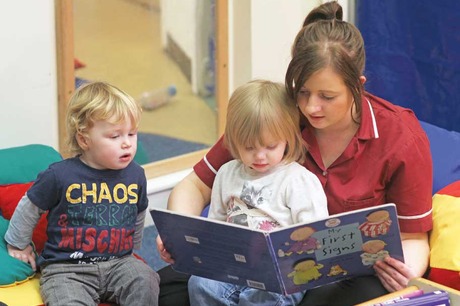
STORIES ARE EVERYWHERE
We are all storytellers, and we don't outgrow our constant reliance on stories in daily life.
- You plan to meet a friend you haven't seen for a while, and you look forward to catching up on important events.
- You are feeling stressed when you arrive at work, and telling someone what is going on helps create a bond as well as making you feel better.
- A puddle appears on the floor after a wet and windy night, and you tell yourself how it happened to understand the cause and what to do about it.
- A child is uncharacteristically unsettled and you share stories with the parent about what is happening in nursery and at home so you can build an understanding about the cause and how you might best respond.
- As you sleep, your dreams tell stories to sort out and reflect on experiences from your waking hours, while daydreaming as you do the washing up serves the same purpose.
- To make a decision, you mentally tell yourself the stories of what would happen if you chose the various options - then you are ready to choose which story to play out.
Storymaking is an essential human activity, which takes us beyond the physical experiences of the current moment to make connections to what we have experienced in the past, to possible futures, to people's emotions and intentions and to patterns that link it all together.
The stories that we tell ourselves define who we think we are, and how we relate to everything and everyone else.
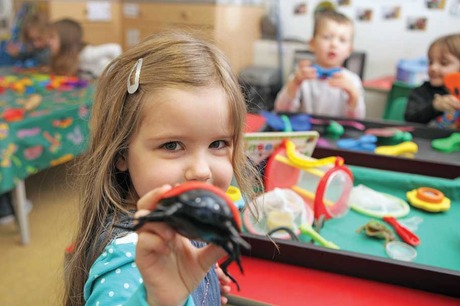
WHAT IS A STORY?
Stories come in an infinite variety and can deal with any topic, but they have basic elements in common. A story can be thought of as any narrative that has:
- characters - someone is in the story
- setting - there is a time and place
- plot - something happens
- a goal or challenge - something is encountered that has to be dealt with
- an outcome - the story is about something that is resolved.
These may sound more like basics from a literature course than something relevant to young children, but consider Mia's story at 22 months as she and her grandmother tell Mia's mother about their outing to the park:
Grandmother You went up the ladder, didn't you? You held on tight.
Mia Boy go on ladder.
Grandmother You were following that boy with the blue coat. You were running after him.
Mia Boy die.
Grandmother (puzzled) What did the boy do?
Mia Boy die. Waa-aaa.
Grandmother Oh, the boy cried. He fell down when he was running and he cried.
Mia Daddy pick up boy.
Grandmother Yes, his daddy picked him up and gave him a cuddle. Then he stopped crying.
Mia Daddy cuddle boy.
The elements of a story came naturally to Mia: character (the boy), setting (the park this morning), plot (he goes up a ladder, he falls down, he is cuddled), challenge (he is hurt and upset), outcome (he is comforted). And, of course, this story covers important territory for a young child who is working out her understanding of events, emotions and relationships.
Telling stories includes:
- recounting things that have happened to us
- retelling stories that we have heard, and
- creating new fantasy accounts.
Often, all three of these are woven together in young children's stories.
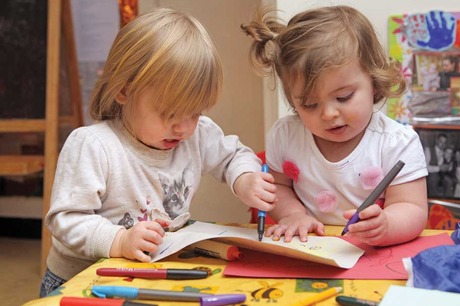
ARE WE HARD-WIRED FOR STORIES?
Some theorists believe that the elements of narrative are hard-wired into our brains, perhaps building on a pattern that craves order and sequence. Our awareness is flooded with sensations and experiences, but our brain automatically looks for ways to group these so that they are not separate but can be understood together, with one thing causing another.
Telling ourselves a story enables us to put events and emotions into a recognisable pattern. When we make narrative links in this way, we are rewarded with the recognition of a pattern, which may release the brain chemical dopamine, involved in the reward system and feelings of pleasure.
The left hemisphere of the brain has been described as the 'interpreter' of all our experience, creating a running narrative of all our experiences and feelings. Brain imaging shows that when we muse silently on something that has happened, it activates both the language production and comprehension centres in the left side of the brain. We also vicariously experience whatever the story is about, so if someone is running in the story our brain motor centres are activated, and emotional centres respond to the emotions in the story.
THE IMPORTANCE OF NARRATIVE
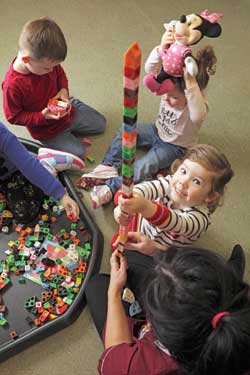 A story narrative helps us to think and learn. Young children are in some ways like scientists. They:
A story narrative helps us to think and learn. Young children are in some ways like scientists. They:
- take in sensory information about objects and events
- form theories about what is happening
- make predictions, and
- test by repeating the actions.
But the scientific way of understanding the world can't cover everything we need to understand. While it can lead us to predict from previous evidence that if we drop something it will fall to the ground, it can't help us to speculate about more abstract things such as what might happen in new situations or to understand emotions and intentions.
With a story explanation, children can:
- think about events they have never seen
- understand how feelings are linked to situations and responses from other people
- draw on past feelings and responses to imagine a new situation, and
- bring together a range of events and information to help make sense of it all and remember a range of details.
A tool for thinking
In their review of research on learning and development to inform the revised Early Years Foundation Stage, Maria Evangelou, Kathy Sylva and their colleagues comment, 'Narrative enables children to create a meaningful personal and social world, but is also is a "tool for thinking". It is most effective when children are encouraged to form their own accounts, rather than passively accepting those of adults.'
As children begin to use language and to represent things symbolically in their play between the ages of one and three, they develop a uniquely human ability to think beyond the immediate physical world. It may be that narrative became part of our human inheritance because it is essential to our survival. It allows us to think in an open-ended way, experiencing possibilities, feelings and events safely, thinking ahead about possible dangers and solutions.
Studies have repeatedly found that people of all ages think more logically when we are given confusing information in a story situation rather than in a real-life context, probably because we are less bound by what we think we know and are able to make logical links more effectively. We also learn information and can recall it more accurately when it is part of a story context.
Narrative is also a critical part of our social and emotional development. We share our culture through stories, and each culture, community and family uses its own stories to build a common sense of identity.
We also build our individual identity through the stories we tell ourselves of our own lives. Researchers say children learn to make sense of both their social context and of emotions through 'scripts' for particular situations. In stories, children can experience fear, anger, love and comfort in a safe way.
The stories children tell themselves, with their own role as central character and other characters involved, provide the opportunity to try out different emotions, motivations and ideas about what they are good at or what they enjoy doing, gradually defining how they see themselves and helping them to empathise with others.
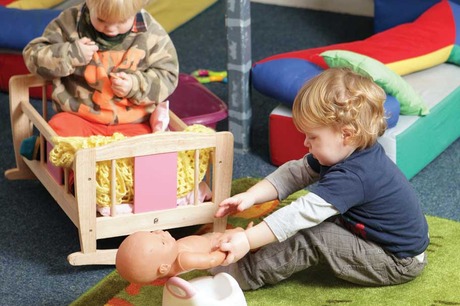
BECOMING STORYTELLERS
As with all tools for thinking, nature and nurture both have a role in children becoming adept storytellers. Inborn potential is supported when adults model and encourage children to form their own story accounts.
Even before babies use language themselves, we model forming stories by talking about what we did in the past - for example, you might say, 'We went out in the rain, didn't we? We saw the rain go splash, splash!' This chat about what we have done, recalling and describing events, helps children to form an idea of the past and of a sequence of events.
The more toddlers and their caregivers recall events in this way, the more children are likely to become able language users and thinkers themselves. In recalling events with adults, they begin to add more details, including things the adult may not have noticed, and eventually can tell a whole account themselves when they have an interested listener.
It is also important to talk about the future - what we will do later today, or even plans for further ahead. This helps children to move their thinking out of the immediate context, and to form internal narratives about what will be or might be.
An enormous leap into the unique human ability to think occurs in the toddler years, when children begin to use symbols; they develop language and they begin to pretend. Both of these are intimately connected with telling stories.
When a small child cuddles a doll and puts it to bed, this is a story. Making the toy car drive along the road or burying a dinosaur in the sand tray becomes storytelling as soon as the child puts words to the physical actions: 'Car driving to the shops. Crash! It broke down.' 'He's gone to sleep. You can't see him. Oh, he waked up.' As children begin to take on roles themselves in imaginative play, they create first their own narrative and later, by age three or four, are able to develop stories with other children.
Through hearing a wide range of stories and repetition of familiar tales, children pick up the form and language and begin to weave them into their play narratives. It is not unusual to hear a small child 'read' a familiar storybook word perfectly, and this helps them to master models of how stories are put together.
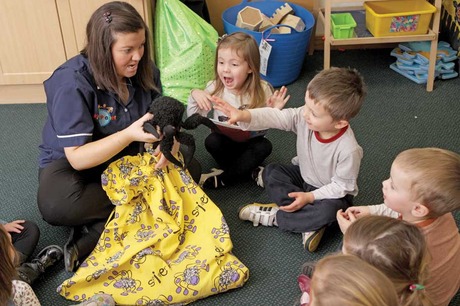
HOW TO SUPPORT STORYTELLING IN YOUR SETTING
A world of possibility opens up when you make children's own accounts a central focus of your practice. Vivian Gussin Paley, whose pioneering work on children's stories is described later in this piece, recommends getting in the habit of seeing yourself and the children as characters in a story.
'We find ourselves being kinder and more respectful to one another because our options have grown in intimacy, humour and literary flavour,' she says. She describes a story as 'letting me know what I know', while 'when you tell someone your story, that person enters the story and becomes your friend too.'
Play and talk are at the centre
Children's storymaking is closely tied to play. Stories emerge in their play as they act out the open-ended experiences, ideas and feelings they want to explore.
It is important to observe play, and encourage children to build on their emerging stories. For example:
- Small-world play providing props and materials relevant to children's interests enables them to create a story. For the youngest children, narrating their actions helps to make the story clear, while joining in when appropriate to follow children's lead encourages focus and more detailed play.
- Role play open-ended materials and fabrics allow children to be inventive and identify the characters and situations they want to explore. The focus and plot may change frequently as the play progresses.
- Construction play alone or in groups, children can use open-ended materials to build the objects or setting they need for the story that is in their minds.
- Designing and making children may represent their experiences or thoughts using any creative materials. Responding with interest to children's comments as they work will encourage them to elaborate their account and perhaps add more detail.
Further storymaking can grow from regularly reviewing play. Taking photos and encouraging children to tell what was happening gives an opportunity for them to tell and retell the story, while comments and open-ended questions will invite them to elaborate further.
Children act as models for each other so they can build on each other's themes and ideas as they play, and scribing their words will highlight the importance of their stories.
As well as a climate that encourages everyday conversations where adults and children talk about their experiences, planned approaches can put storymaking in the foreground.
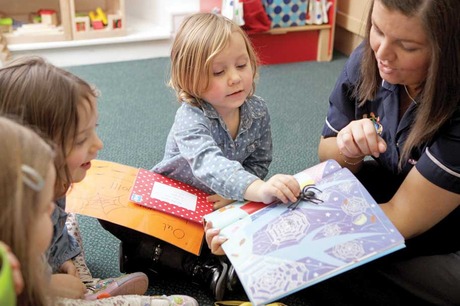
STORYMAKING ACTIVITIES
- Photo 'puppets' to put children in their own stories laminate and cut out small whole-body photos of the children, possibly mounted on lolly sticks. Take them outdoors, or use them with pictures of superheroes or wild animals for adventures.
- Objects to spark story ideas put a collection of objects in a bag or box, and as they are unpacked create a story together about their owner.
- Story sacks encourage children to use the book, objects, small-world figures or puppets to retell a story and then to extend it. What happened next? What else happened?
- Symbols for story boards or ropes develop a set of symbols to stand for the elements of a story - who, where, when, what happens, how it ends. For a storyboard, use these to build a group story, with children adding suggestions as you draw an image to represent their ideas. The symbols stretched along a rope work in the same way. Children can use these supports for recounting everyday news, or for telling and retelling imaginary stories.
- Story chairs and story nooks create special places for children to tell stories, to each other or even to toy friends.
- Talking tables developed by Fleur Griffiths, this idea involves a small number of children gathered round a table with a responsive adult, a few small objects, a large piece of paper and markers, developing a story together as they represent their ideas.
- Storytelling and story acting, or the 'Helicopter Technique' In this approach, described by Vivian Gussin Paley in her many inspiring and entertaining books, children dictate stories to an adult. Later, the group becomes the actors and the adult the stage director as they 'play' the story as it is read out by the adult. Research on this work in the UK shows marked gains for children's confidence, communication and motivation to engage in literacy activities.
Nancy Stewart is principal consultant at Early Learning Consultancy. Photos at Kids Planet Warrington by Guzelian
MORE INFORMATION
- Early Years Learning and Development Literature Review by Maria Evangelou, Kathy Sylva and Maria Kyriacou from the Department of Education at University of Oxford, and Mary Wild and Georgina Glenny from Westminster Institute of Education at Oxford Brookes University (2009), http://dera.ioe.ac.uk/11382/2/DCSF-RR176.pdf
- MakeBelieve Arts (www.makebelievearts.co.uk) provides information, workshops and training on the Helicopter Technique.
- The Storytelling Animal: how stories make us human by Jonathan Gottschall
- The Helicopter Resource Pack by Trisha Lee, MakeBelieveArts
- The Talking Table for Child-Centred Conversations by Fleur Griffiths, www.ierg.net/confs/viewpaper.php?id=306&cf=2
- Wally's Stories or The Boy Who Would be a Helicopter by Vivian Gussin Paley.









